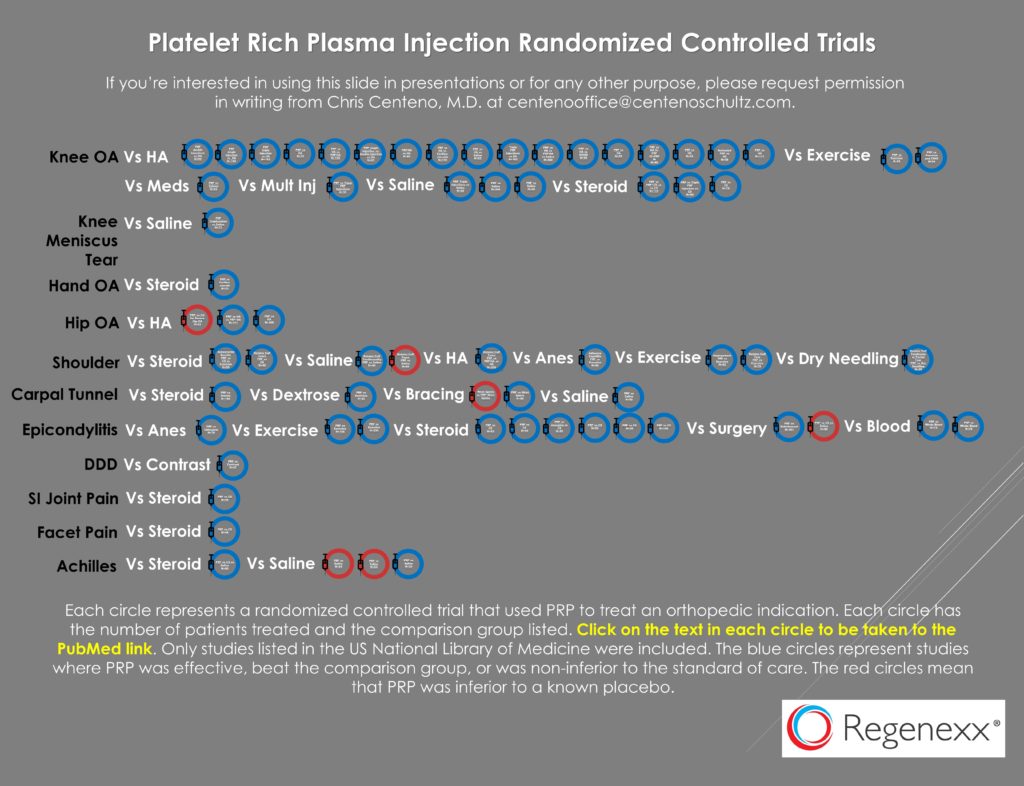My PRP Injection RCT Infographic: Google Screwed Up
As you might recall, Google made the decision this year to restrict medical clinic advertising for PRP (platelet rich plasma). However, was that a move based on the scientific literature or just bad advice? After spending days distilling all of the PRP RCTs down to a single diagram, it’s clear that Google got bad advice. Let’s dig in.
Google PRP Ad Ban
The bench scientist crowd working with universities to commercialize expensive orthopedic cell-based products is afraid of PRP. Why? It’s dirt cheap compared to the products their universities are trying to push through the regulatory gantlet. If these products can’t beat PRP, their commercial prospects are toast, as why would United Healthcare pay 20-40X more for an expensive cell-based product when it can’t beat a cheap autologous product? Hence, it wasn’t a big surprise to me that Google’s recent stem cell advertising ban threw the PRP baby out with the fake stem cell bathwater. Why? They got their advice from university bench scientists.
Let’s Do What the Bench Scientists Didn’t Do-Look at the Science
I ran multiple searches on PubMed for PRP injections and various orthopedic diseases looking for randomized controlled trials. I found 66 RCTs covering 12 different orthopedic conditions. 60 of those showed that PRP was effective, was non-inferior to, or better than the comparison group. The conclusion? Despite heterogeneity in what was considered PRP, there is no orthopedic surgery currently covered by insurance and performed at every major university that is as well researched as PRP. That’s why all of the medical schools where the Google bench scientist advisors work inject PRP.
How to Use The Infographic
I created the above infographic so that someone who didn’t know this literature (like the bench scientists or Google) can quickly see what’s published. First, click on the image above to get a higher quality PDF (or here). Each circle represents a different study. The blue circles represent studies where PRP was effective and the red where it was ineffective. The clinical indications or body areas treated are listed on the y-axis to the left. The sub-titles are the treatments PRP was tested against. If you click on the text in a circle it links to the Pubmed listing.
Time for Bench Scientists to Eat Some Humble Pie
You guys know who you are. You need to admit that your position on PRP was not scientifically accurate. How bad was this advice to Google? All of these surgical procedures performed at all of your medical schools have far less RCT back up than PRP:
- Lumbar fusion
- Spinal decompression for stenosis
- Arthroscopic partial meniscectomy
- Shoulder rotator cuff repair-all types and all tear sizes
- ACL reconstruction
- Ankle fusion (triple arthrodesis)
- Knee arthroplasty
- Shoulder arthroplasty
- Knee microfracture
- Discectomy
I could go on…
If You Want to Use the Infographic
This new slide is definitely going into the talks I give, including one coming up at the annual A4M conference in Vegas. If you want to use the slide in a talk or presentation, then please ping me at [email protected] for permission. You must give the author credit and the slide must be presented “as is”. In addition, the slide can’t be used for commercial purposes to sell anything, but only for scientific or educational purposes.
The upshot? Google made a bad non-science based decision here. It needs to reverse its policy. Finally, their bench scientist advisors who have dedicated their lives to science need to actually live by that credo by admitting they didn’t actually read these 66 studies.

If you have questions or comments about this blog post, please email us at [email protected]
NOTE: This blog post provides general information to help the reader better understand regenerative medicine, musculoskeletal health, and related subjects. All content provided in this blog, website, or any linked materials, including text, graphics, images, patient profiles, outcomes, and information, are not intended and should not be considered or used as a substitute for medical advice, diagnosis, or treatment. Please always consult with a professional and certified healthcare provider to discuss if a treatment is right for you.

